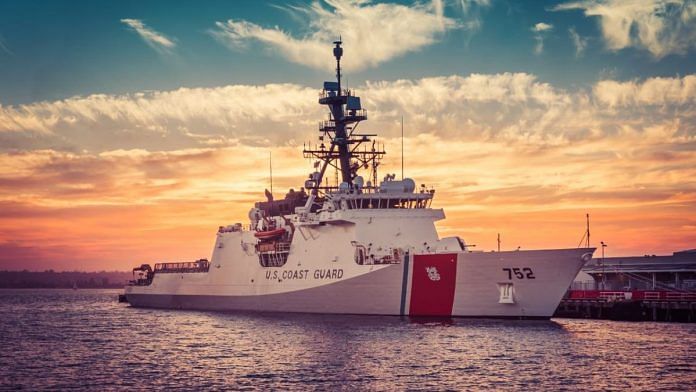New Delhi: India, Japan, the United States and Australia, the four members of the Quadrilateral Security Dialogue (QUAD), launched their first-ever joint coast guard-led at-sea observer mission to improve interoperability and advance maritime safety in the Indo-Pacific.
The development comes ahead of External Affairs Minister S. Jaishankar’s visit to the US for the Quad Foreign Ministers’ Meeting, scheduled for Tuesday.
At the meeting, the Ministry of External Affairs (MEA) said Sunday, the foreign ministers of the four countries would exchange views on regional and global developments, particularly in the Indo-Pacific. They will also review progress on various Quad initiatives in the lead-up to the Quad Leaders’ Summit, hosted by India.
According to MEA, “the ministers are further expected to consider new proposals to advance a shared vision of a free and open Indo-Pacific”.
The Ministry of Defence announced the launch of the ‘QUAD at Sea Ship Observer Mission’ in a statement Monday. A team of two officers from each country, including women officers, is aboard the vessel, USCGC Stratton. The ship is en route to Guam in the western Pacific Ocean.
According to the US Coast Guard website, Stratton is one of ten high-endurance Legend-class National Security Cutters in the US Coast Guard fleet. Commissioned in 2012, the nearly 418-foot-long vessel has a full-load displacement of around 4,600 long tonnes and is equipped for a wide range of missions, including drug interdiction, fisheries enforcement, maritime security, environmental protection, and search and rescue operations.
The mission is being conducted under the framework of the Wilmington Declaration, a joint statement issued by the QUAD Leaders’ Summit, held in September last year in Wilmington, Delaware.
It included plans for the “first-ever Quad-at-Sea Ship Observer Mission in 2025 to improve interoperability and advance maritime safety,” with similar missions to follow across the Indo-Pacific.
In addition to that, the current mission also seeks to reinforce a shared commitment to a “Free, Open, Inclusive and Rules-Based Indo-Pacific” and underlines the growing operational ties between the Indian Coast Guard (ICG), Japan Coast Guard (JCG), US Coast Guard (USCG) and Australian Border Force (ABF).
India’s participation, the defence ministry statement said, aligns with the country’s maritime doctrine of SAGAR (Security and Growth for All in the Region) and supports the broader Indo-Pacific Oceans Initiative (IPOI), which focuses on regional capacity-building, humanitarian outreach, and maritime law enforcement.
Also Read: ‘Looking to make Quad more effective with Trump,’ says Australian envoy to India
New dimension in maritime cooperation
This deployment also marks a new dimension in QUAD maritime cooperation, shifting emphasis from traditional naval exercises to coast guard-level interoperability and maritime domain awareness. It builds on existing defence cooperation among the four countries, including the annual Malabar naval exercise.
The annual multilateral exercise focuses on enhancing interoperability, improving tactical coordination and addressing shared maritime security challenges in the Indian Ocean and Indo-Pacific regions. The drills include surface and anti-submarine warfare, air defence, maritime patrol operations, replenishment at sea and cross-deck helicopter landings.
The exercise usually features the participation of various Indian naval platforms, including guided missile destroyers, multi-purpose frigates, submarines, fighter aircraft and helicopters.
The naval exercise began in 1992 as a bilateral naval drill between the navies of India and the US. Japan joined in 2007, becoming a regular participant in 2014, and being formally included as a permanent member in 2015.
While Australia also present in 2007, it withdrew from the QUAD in the following year after objections from China over its participation in the exercise.
The grouping was revived in subsequent years, with Australia returning in 2020. That year, Malabar evolved into a four-nation format with all four QUAD nations participating together for the first time.
China has continued to criticise the bloc, accusing it of trying to contain its regional influence and “inciting confrontation”.
Last year, India had hosted the annual edition of the Malabar naval exercise, with both the harbour and sea phases taking place in and around Visakhapatnam and the Bay of Bengal. The Indian Navy contributed a range of platforms, including guided-missile destroyers, multi-role frigates, and the long-range maritime patrol aircraft P-8I, which is equipped for anti-submarine warfare and surveillance missions.
The United States Navy had participated with the USS Dewey, an Arleigh Burke-class guided-missile destroyer, accompanied by its embarked helicopter and a P-8A Poseidon maritime patrol aircraft. Japan had deployed the JS Ariake, a guided-missile destroyer from the Akizuki class, known for its advanced air defence capabilities; while the Royal Australian Navy had fielded the HMAS Stuart, a frigate, along with a MH-60R Seahawk helicopter, designed for anti-submarine and anti-surface warfare and a P-8A maritime patrol aircraft.
(Edited by Sanya Mathur)






